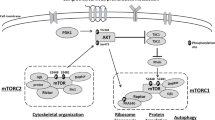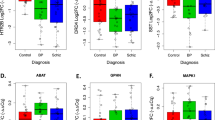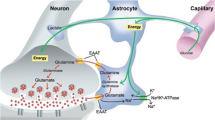Abstract
Recent molecular genetics studies implicate neuregulin 1 (NRG1) and its receptor erbB in the pathophysiology of schizophrenia1,2,3. Among NRG1 receptors, erbB4 is of particular interest because of its crucial roles in neurodevelopment and in the modulation of N-methyl-D-aspartate (NMDA) receptor signaling4,5,6. Here, using a new postmortem tissue–stimulation approach, we show a marked increase in NRG1-induced activation of erbB4 in the prefrontal cortex in schizophrenia. Levels of NRG1 and erbB4, however, did not differ between schizophrenia and control groups. To evaluate possible causes for this hyperactivation of erbB4 signaling, we examined the association of erbB4 with PSD-95 (postsynaptic density protein of 95 kDa), as this association has been shown to facilitate activation of erbB4. Schizophrenia subjects showed substantial increases in erbB4–PSD-95 interactions. We found that NRG1 stimulation suppresses NMDA receptor activation in the human prefrontal cortex, as previously reported in the rodent cortex. NRG1-induced suppression of NMDA receptor activation was more pronounced in schizophrenia subjects than in controls, consistent with enhanced NRG1-erbB4 signaling seen in this illness. Therefore, these findings suggest that enhanced NRG1 signaling may contribute to NMDA hypofunction in schizophrenia.
This is a preview of subscription content, access via your institution
Access options
Subscribe to this journal
Receive 12 print issues and online access
$209.00 per year
only $17.42 per issue
Buy this article
- Purchase on Springer Link
- Instant access to full article PDF
Prices may be subject to local taxes which are calculated during checkout




Similar content being viewed by others
Change history
19 December 2023
An Editorial Expression of Concern to this paper has been published: https://doi.org/10.1038/s41591-023-02757-y
References
Stefansson, H. et al. Neuregulin 1 and susceptibility to schizophrenia. Am. J. Hum. Genet. 71, 877–892 (2002).
Williams, N.M. et al. Support for genetic variation in neuregulin 1 and susceptibility to schizophrenia. Mol. Psychiatry 8, 485–487 (2003).
Corvin, A.P. et al. Confirmation and refinement of an 'at-risk' haplotype for schizophrenia suggests the EST cluster, Hs.97362, as a potential susceptibility gene at the Neuregulin-1 locus. Mol. Psychiatry 9, 208–213 (2004).
Anton, E.S. et al. Receptor tyrosine kinase ErbB4 modulates neuroblast migration and placement in the adult forebrain. Nat. Neurosci. 7, 1319–1328 (2004).
Rieff, H.I. et al. Neuregulin induces GABA(A) receptor subunit expression and neurite outgrowth in cerebellar granule cells. J. Neurosci. 19, 10757–10766 (1999).
Ozaki, M., Sasner, M., Yano, R., Lu, H.S. & Buonanno, A. Neuregulin-β induces expression of an NMDA-receptor subunit. Nature 390, 691–694 (1997).
Stefansson, H., Steinthorsdottir, V., Thorgeirsson, T.E., Gulcher, J.R. & Stefansson, K. Neuregulin 1 and schizophrenia. Ann. Med. 36, 62–71 (2004).
Fischbach, G.D. & Rosen, K.M. ARIA: a neuromuscular junction neuregulin. Annu. Rev. Neurosci. 20, 429–458 (1997).
Buonanno, A. & Fischbach, G.D. Neuregulin and ErbB receptor signaling pathways in the nervous system. Curr. Opin. Neurobiol. 11, 287–296 (2001).
Lemke, G. Glial control of neuronal development. Annu. Rev. Neurosci. 24, 87–105 (2001).
Arnold, S.E., Talbot, K. & Hahn, C.G. Neurodevelopment, neuroplasticity, and new genes for schizophrenia. Prog. Brain Res. 147, 319–345 (2005).
Harrison, P.J. & Weinberger, D.R. Schizophrenia genes, gene expression, and neuropathology: on the matter of their convergence. Mol. Psychiatry 10, 40–68 (2005).
Rio, C., Rieff, H.I., Qi, P., Khurana, T.S. & Corfas, G. Neuregulin and erbB receptors play a critical role in neuronal migration. Neuron 19, 39–50 (1997).
Okada, M. & Corfas, G. Neuregulin1 downregulates postsynaptic GABAA receptors at the hippocampal inhibitory synapse. Hippocampus 14, 337–344 (2004).
Huang, Y.Z. et al. Regulation of neuregulin signaling by PSD-95 interacting with ErbB4 at CNS synapses. Neuron 26, 443–455 (2000).
Gu, Z., Jiang, Q., Fu, A.K., Ip, N.Y. & Yan, Z. Regulation of NMDA receptors by neuregulin signaling in prefrontal cortex. J. Neurosci. 25, 4974–4984 (2005).
Hashimoto, R. et al. Expression analysis of neuregulin-1 in the dorsolateral prefrontal cortex in schizophrenia. Mol. Psychiatry 9, 299–307 (2004).
Frenzel, K.E. & Falls, D.L. Neuregulin-1 proteins in rat brain and transfected cells are localized to lipid rafts. J. Neurochem. 77, 1–12 (2001).
Wang, H.Y. & Friedman, E. Receptor-mediated activation of G proteins is reduced in postmortem brains from Alzheimer's disease patients. Neurosci. Lett. 173, 37–39 (1994).
Wang, H.Y. & Friedman, E. Enhanced protein kinase C activity and translocation in bipolar affective disorder brains. Biol. Psychiatry 40, 568–575 (1996).
Garcia, R.A., Vasudevan, K. & Buonanno, A. The neuregulin receptor ErbB-4 interacts with PDZ-containing proteins at neuronal synapses. Proc. Natl. Acad. Sci. USA 97, 3596–3601 (2000).
Clinton, S.M. & Meador-Woodruff, J.H. Abnormalities of the NMDA receptor and associated intracellular molecules in the thalamus in schizophrenia and bipolar disorder. Neuropsychopharmacology 29, 1353–1362 (2004).
Toyooka, K. et al. Selective reduction of a PDZ protein, SAP-97, in the prefrontal cortex of patients with chronic schizophrenia. J. Neurochem. 83, 797–806 (2002).
Coyle, J.T., Tsai, G. & Goff, D. Converging evidence of NMDA receptor hypofunction in the pathophysiology of schizophrenia. Ann. NY Acad. Sci. 1003, 318–327 (2003).
Moghaddam, B. Bringing order to the glutamate chaos in schizophrenia. Neuron 40, 881–884 (2003).
Kwon, O.B., Longart, M., Vullhorst, D., Hoffman, D.A. & Buonanno, A. Neuregulin-1 reverses long-term potentiation at CA1 hippocampal synapses. J. Neurosci. 25, 9378–9383 (2005).
Harrison, P.J. & Owen, M.J. Genes for schizophrenia? Recent findings and their pathophysiological implications. Lancet 361, 417–419 (2003).
Acknowledgements
We express our gratitude to collaborating state hospitals of the Commonwealth of Pennsylvania, and, above all, to the patients and their families for their participation. We also acknowledge the clinical staff and residents of the Schizophrenia Research Center and Division of Medical Pathology at the University of Pennsylvania for subject assessment and autopsy. This work was supported by grants from the US National Institutes of Health (MH64045 and MH63946).
Author information
Authors and Affiliations
Corresponding author
Ethics declarations
Competing interests
The authors declare no competing financial interests.
Supplementary information
Supplementary Fig. 1
NRG1 or NMDA stimulation activates intracellular signal transduction in postmortem brains. (PDF 50 kb)
Supplementary Fig. 2
NRG1 stimulation induces erbB4 activation in mouse brains at varied postmortem intervals. (PDF 65 kb)
Supplementary Fig. 3
Haloperidol treatment does not enhance NRG1 induced erbB4 activation. (PDF 64 kb)
Supplementary Fig. 4
Association of erbB4 with NMDAR is enhanced in PFCs of SCZ subjects. (PDF 53 kb)
Supplementary Fig. 5
Association of PSD-95 with NMDAR is enhanced in the PFC of SCZ subjects. (PDF 49 kb)
Supplementary Fig. 6
ErbB4 expression in human postmortem brains. (PDF 158 kb)
Supplementary Table 1
Demographic information on the subjects of postmortem brains. (PDF 70 kb)
Rights and permissions
About this article
Cite this article
Hahn, CG., Wang, HY., Cho, DS. et al. Altered neuregulin 1–erbB4 signaling contributes to NMDA> receptor hypofunction in schizophrenia. Nat Med 12, 824–828 (2006). https://doi.org/10.1038/nm1418
Received:
Accepted:
Published:
Issue Date:
DOI: https://doi.org/10.1038/nm1418
This article is cited by
-
Neuregulin-1 and ALS19 (ERBB4): at the crossroads of amyotrophic lateral sclerosis and cancer
BMC Medicine (2024)
-
Editorial Expression of Concern: Altered neuregulin 1–erbB4 signaling contributes to NMDA> receptor hypofunction in schizophrenia
Nature Medicine (2023)
-
Prenatal dexamethasone exposure induces anxiety- and depressive-like behavior of male offspring rats through intrauterine programming of the activation of NRG1-ErbB4 signaling in hippocampal PV interneurons
Cell Biology and Toxicology (2023)
-
Antipsychotic drugs increase Neuregulin1β1 serum levels in first-episode drug-naïve patients and chronic schizophrenia with suggestions for improving the treatment of psychotic symptoms
BMC Psychiatry (2022)
-
NRG1 knockdown rescues PV interneuron GABAergic maturation deficits and schizophrenia behaviors in fetal growth restriction mice
Cell Death Discovery (2022)



